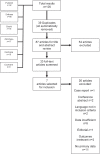Pathological eating behaviours and risk of retinopathy in diabetes: a systematic review and meta-analysis
- PMID: 35673454
- PMCID: PMC9167365
- DOI: 10.1007/s40200-022-00980-x
Pathological eating behaviours and risk of retinopathy in diabetes: a systematic review and meta-analysis
Abstract
Background: Diabetes mellitus can cause several long-term macrovascular and microvascular complications including nephropathy, neuropathy, and retinopathy (DR). Several studies have reported positive associations between eating pathologies and DR; however, these studies have not been aggregated and sub-grouped into type of pathological eating behaviour, and the differences in risk according to type of eating behaviour is unknown. The aim of this review, therefore, was to aggregate risks of DR in populations with and without pathological eating behaviours, stratified according to eating behaviour.
Methods: A systematic review and meta-analysis was conducted. Major databases and grey literature were search from inception until 1/6/2021. Studies reporting the prevalence of pathological eating behaviours (against a control group with no pathological eating behaviours) in diabetic people with and without DR were included. Odds ratios were calculated from primary data.
Results: Seven studies with eight independent outcomes with a total of 1162 participants were included. The odds ratio of DR in the total pooled analysis was 2.94 (95%CI 1.86-4.64; p = <0.001; I2 = 29.59). Two types of eating behaviour yielded enough data for sub-group analysis. Eating disorder not otherwise specified yielded an odds ratio of 2.73 (95%CI 1.81-4.10; p = <0.001; I2 = 0.00), and binge eating disorder yielded an non-significant odds ratio of 0.92 (95%CI 0.31-2.77; p = 0.887;I2 = 0.00).
Discussion: The likelihood of DR increases almost three times in the presence of pathological eating behaviours. More studies are required to confirm this in clinical populations stratified by eating disorder. Practitioners working with people with diabetes should closely monitor eating behaviours to preclude this risk.
Supplementary information: The online version contains supplementary material available at 10.1007/s40200-022-00980-x.
Keywords: Diabetes; Diabetic retinopathy; Disordered eating; Eating disorder.
© Springer Nature Switzerland AG 2022.
Conflict of interest statement
Conflict of interestAll authors declare no conflict of interest.
Figures



Similar articles
-
Global Prevalence of Diabetic Retinopathy in Pediatric Type 2 Diabetes: A Systematic Review and Meta-analysis.JAMA Netw Open. 2023 Mar 1;6(3):e231887. doi: 10.1001/jamanetworkopen.2023.1887. JAMA Netw Open. 2023. PMID: 36930156 Free PMC article.
-
Validation of the traditional Chinese version of the diabetes eating problem survey-revised and study of the prevalence of disordered eating patterns in Chinese patients with type 1 DM.BMC Psychiatry. 2023 May 31;23(1):382. doi: 10.1186/s12888-023-04744-6. BMC Psychiatry. 2023. PMID: 37259043 Free PMC article.
-
Association of Diabetic Retinopathy With Stroke: A Systematic Review and Meta-Analysis.Front Neurol. 2021 Mar 16;12:626996. doi: 10.3389/fneur.2021.626996. eCollection 2021. Front Neurol. 2021. PMID: 33796063 Free PMC article.
-
Diagnosing type 2 diabetes using Hemoglobin A1c: a systematic review and meta-analysis of the diagnostic cutpoint based on microvascular complications.Acta Diabetol. 2021 Mar;58(3):279-300. doi: 10.1007/s00592-020-01606-5. Epub 2020 Nov 3. Acta Diabetol. 2021. PMID: 33141338 Free PMC article.
-
The misuse of insulin by males with Type 1 Diabetes Mellitus for weight and/or shape control: a systematic scoping review.J Diabetes Metab Disord. 2022 Nov 15;22(1):13-34. doi: 10.1007/s40200-022-01151-8. eCollection 2023 Jun. J Diabetes Metab Disord. 2022. PMID: 37255778 Free PMC article.
Cited by
-
Associations between diabetic retinopathy, mortality, disease, and mental health: an umbrella review of observational meta-analyses.BMC Endocr Disord. 2022 Dec 9;22(1):311. doi: 10.1186/s12902-022-01236-8. BMC Endocr Disord. 2022. PMID: 36494641 Free PMC article.
-
The prevention opportunities of retinopathy in diabetic patients - position paper endorsed by the Polish Lipid Association.Arch Med Sci. 2024 Dec 13;20(6):1754-1769. doi: 10.5114/aoms/197331. eCollection 2024. Arch Med Sci. 2024. PMID: 39967951 Free PMC article.
-
Corneal Refractive Surgery Considerations in Patients with Anorexia Nervosa.Clin Ophthalmol. 2024 Dec 25;18:3925-3934. doi: 10.2147/OPTH.S497690. eCollection 2024. Clin Ophthalmol. 2024. PMID: 39737364 Free PMC article. Review.
-
Renal failure following insulin purging in atypical anorexia nervosa and type 1 diabetes mellitus.Front Psychiatry. 2023 Dec 11;14:1325021. doi: 10.3389/fpsyt.2023.1325021. eCollection 2023. Front Psychiatry. 2023. PMID: 38152359 Free PMC article.
References
-
- diabetes.co.uk. Dry mouth and diabetes. 2020. https://www.diabetes.co.uk/diabetes-complications/dry-mouth.html. Accessed 28 Jul 2020.
Publication types
LinkOut - more resources
Full Text Sources

